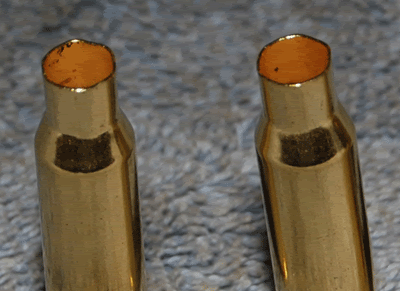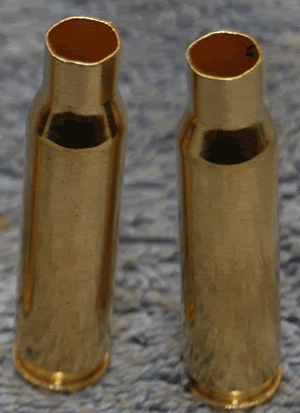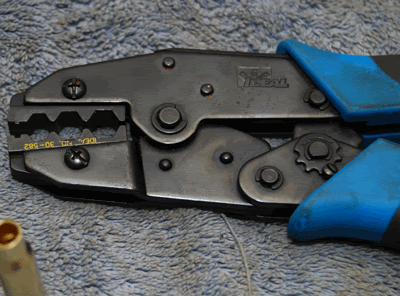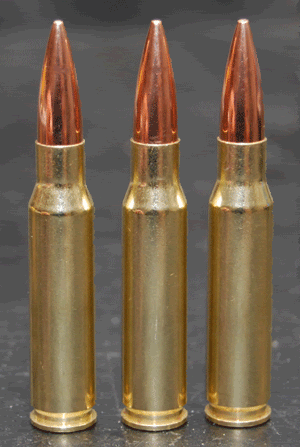

 The Accurate Reloading Forums
The Accurate Reloading Forums  THE ACCURATE RELOADING.COM FORUMS
THE ACCURATE RELOADING.COM FORUMS  Guns, Politics, Gunsmithing & Reloading
Guns, Politics, Gunsmithing & Reloading  Reloading
Reloading  hexagon crimp .30 Cal
hexagon crimp .30 CalGo  | New  | Find  | Notify  | Tools  | Reply  |  |
| One of Us |
Thought I would share this odd but extremely effective crimp method I devised a few years back. Nothing more bogus than seating bullets that just slide back and forth when your done. Sanding down the neck Collete and conventional crimps never seemed to work for me and always effected my accuracy. So one day I was playing with a friends tool (Cable "f" crimpper) and the rest is history for me. The center crimp is perfect and the bullet slides in with consistent pressure every time and holds the bullet tight (use in my m1 no problem) and has even added to my accuracy. Kind of odd, maybe done before but works great!     | ||
|
| new member |
Are you serious? If you can not get proper neck tension, then there is something more serious flubbed up in the loading process. | |||
|
| One of Us |
With proper neck tension, it is hard to pull a bullet without a lot of force. I think you should check your resizing die. | |||
|
| one of us |
interesting, Cant say I have ran across that. john, We have roll crimps tapper crimps factory crimps Why not an octy crimp? Dave | |||
|
| new member |
There are some very specific applications where crimping will provide a benefit. Crimping a rifle cartridge, utilizing a bullet w/o a cannelure is not one of them. Irregardless of the crimp die employed, on the whole, bullets can become deformed and or cartridge run-out will increase. Specifications for a particular 5.56x45 contract that my company had, stated a mandatory bullet pull of 60 pounds. The bullet in that contract was a non cannelured 77 grain OTM. Best results were obtained by using properly annealed brass and sizing the neck properly. For that particular bullet, sizing till the inside of the neck was .003" smaller than the OD of the bullet yielded a neck tension of 65-69 pounds. I do realize there are a large number of Lee equipment fanatics out there. And if using a factory crimp die makes you a more confident shooter; then by all means, use them. It would be folly for anyone to tell you otherwise. On the other hand, I know very few competitive shooters that use them, I don't know any that are consistent top finishers in the precision rifle sports. John | |||
|
| One of Us |
Ya got that right. | |||
|
| Moderator |
that's different opinions vary band of bubbas and STC hunting Club Information on Ammoguide about the416AR, 458AR, 470AR, 500AR What is an AR round? Case Drawings 416-458-470AR and 500AR. 476AR, http://www.weaponsmith.com | |||
|
| One of Us |
Can't be water proof!! ________________________________________________ Maker of The Frankenstud Sling Keeper Proudly made in the USA Acepting all forms of payment | |||
|
| One of Us |
Interesting. | |||
|
| One of Us |
Are you serious? If you can not get proper neck tension, then there is something more serious flubbed up in the loading process. ================================================ Serious as heart attack! Looks and sounds like some jacked-up redneck practice but a few years back I tried it and have never turned back! I get perfect and consistent pull pressure (52 Lbs.)with every round! Nothing wrong with my loading gear or dies, I just like the results and so do many of those that have tried it! And by-the-way A FORM FIT IS ALWAYS BETTER THAN A STRETCH FIT. As you can see, the neck forms perfectly from the hex to snug the bullet! Don't knock it unless you've tried it! I've laughed at much stranger just to be humbled later.. | |||
|
| One of Us |
Hey, whatever works. But why, if your dies, setup, and loading procedures are correct, are the bullets sliding back and forth when you're done. | |||
|
| One of Us |
Hey, whatever works. But why, if your dies, setup, and loading procedures are correct, are the bullets sliding back and forth when you're done. ================================================== No, my normal pull is about 22 Lbs. with RCBS and Lee about 33 Lbs. Of course I can always change the collet and get the same results with either or. This all started about 4 years ago when I was shooting Open class with my M1A and I was noticing that even with 30 to 40 Lbs. of pull I was getting movement on about the 5th. or 6th. round. Not at all a fan of crimping, I used my Dillon taper crimp die and experimented with it to death not getting the results I wanted in that; I wanted to get about 50 Lbs. of pull without scoring the bullet. The problem to me is that these crimp dies work well with jacketed bullets but only provide about a 3 to 6 mm crimp. So the obvious was to reduce my Collete size in hopes of pulling the overall neck length in for a tighter fit. In any event, like the story goes I was at a friends when I noticed the tool, went to my truck, got some brass and tried it. To my surprise the "f-type" hex crimp was perfect by (at least in terms of not distorting the neck) putting six small angles in which the bullet had to reform. I took it home and made some test loads, checked the pull weight (52 to 53 Lbs.) and hauled ass to the range. Wal-lah, I thought unbefuc____lievable. Not only did it stop movement in it's tracks, it tightened up my group! It has also proven effective on my Bas-10 and tac7. Not so much with my AI-M21, but it's unreal results have kept me from doing anything else. There is a few others that have tried it and to this day, continue to do so.. | |||
|
| Powered by Social Strata |
| Please Wait. Your request is being processed... |
|

Visit our on-line store for AR Memorabilia

